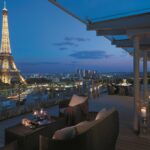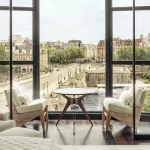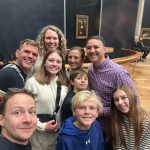Great for raining days, 19th century fans, and shopping enthusiasts – Covered Passages
Paris is full of secret places, testimonies of the city’s history. Discovering them helps to better understand the capital’s past. Take the covered passages of Paris, for example. In the 19th century, thanks to Baron Haussmann’s great urban transformation plan, the capital had more than 70!
Most beautiful covered passages are almost all in the same area: the 2nd and 9th arrondissements. An architectural curiosity that plunges us back into the atmosphere of the 19th century.
- The Véro-Dodat Gallery (Paris 1) 19 rue Jean-Jacques-Rousseau / 2 rue du Bouloi
Located close to the Louvre Museum, Galerie Véro-Dodat has been classified as a historical monument since 1965. On the ground, a beautiful marble pavement with black and white diamonds give a depth effect to the gallery. On the ceiling, a beautiful glass roof and engravings. Since its creation in 1826, the gallery has housed many chic shops: decoration, furniture, art, shoes at Louboutin… It is possible to buy beautiful things there, as long as your finances allow it! - The Passage of Panoramas (Paris 2)10 rue Saint-Marc / 11 boulevard Montmartre / 38 rue Vivienne / 151 rue Montmartre
The Passage des Panoramas, built in 1799, is the first covered passage in Paris and also one of the most famous in the capital. That’s why it doesn’t fill up. Philatelist friends, know that it is one of the main places of philately in Paris, with many shops dedicated to the sale of collectible stamps. - The Vivienne Gallery (Paris 2) 4 rue des Petits-Champs / 6 rue Vivienne / 5 rue de la Banque
With its neo-classical Pompeian style decor, elegant glass roof, imposing dome, colorful mosaic floor and many paintings and sculptures, Galerie Vivienne is one of the most elegant galleries in Paris. Inaugurated in 1826, it has since welcomed many luxury ready-to-wear and interior decoration shops, but also cafes and old book bookstores, just to rest between two purchases. It regained its splendor thanks to the installation between its walls of major luxury brands (Kenzo organized a fashion show there in the 1970s; Jean-Paul Gaultier also settled there for a while). - The Passage du Grand-Cerf (Paris 2) 145 rue Saint-Denis / 10 rue Dussoubs
Opened in 1825 on the site of the Hôtel du Grand Cerf, the Passage du Grand-Cerf did not always look like this. It was, in fact, only in 1845 that he acquired this magnificent glass roof, which made all its charm. Inside, many boutiques of designers, decorators, craftsmen, designers and fashion coexist. - The Cairo Passage (Paris 2) 33 rue d’Alexandrie / 2 place du Caire / 237-239 rue Saint-Denis / 14, 34 and 44 rue du Caire
The Cairo Passage is the Parisian covered passage of all records: the oldest passage still accessible (built in 1798, during Napoleon’s campaign in Egypt), but also the longest (360 meters from one end to the other) and the narrowest. Well, we confess that these are about the only three remarkable characteristics of this passage. Located in the Sentier, it is now invaded by wholesale shops, fabric making and showcase mannequins. - The Colbert Gallery (Paris 2) 6 rue des Petits-Champs / 2 rue Vivienne
Galerie Colbert is the competitor of Galerie Vivienne as the most beautiful Parisian gallery. Don’t wait any longer and discover its magnificent rotunda topped by a glass dome and its dying Eurydice statue, in the center of the rotunda. This beautiful gallery was purchased by the Bibliothèque Nationale de France and today houses several institutes (including the Art History and the Heritage Institute) as well as many research laboratories and schools related to art history. - The Passage of the Princes (Paris 2)5 boulevard des Italiens / 97-99 rue de Richelieu
The Passage des Princes is a very small covered passage of the 2nd arrondissement. It was the last covered passage built in Paris at the time of Baron Haussmann. Admire its beautiful glass roof, erected on metal arches forming arabesques; its pretty 1930-style dome and its width, admirable. Well, what you see these days is not the original passage; no! The Passage of the Princes was, in fact, destroyed in 1985 for a real estate operation, but fortunately rebuilt ten years later, identically! - The Passage Choiseul (Paris 2)40 rue des Petits-Champs / 23 rue Saint-Augustin / 40 rue Dalayrac Passage Sainte-Anne
With its 190 meters long, the Passage Choiseul is one of the largest in Paris (even if far behind the Passage of Cairo and its 360 meters!). Since its opening in 1827, the Passage Choiseul has somewhat lost its superbness with Parisians. And despite the installation of a shop by couturier Kenzo in 1970 (now moved to Place des Victoires), Passage Choiseul never regained its craze of yesteryear. - The Madeleine Gallery (Paris
9 place de la Madeleine / 30 rue Boissy-d’Anglas
The Madeleine Gallery is, you will have guessed, not far from the Church and the Place de la Madeleine. Designed by architect Théodore Charpentier in 1840, the Galerie de la Madeleine was inaugurated in 1846 and was home to many small shops and craftsmen at the time. Now luxury shops have invaded the passage. - The Jouffroy Passage (Paris 9) 10-12 boulevard Montmartre / 9 rue de la Grange-Batelière
The Passage Jouffroy was built in 1836 as an extension of the Passage des Panoramas, in order to benefit the Parisian population drained by the latter. Since then, it has been one of the busiest passages in the capital. The Jouffroy Passage served as a field for the many architectural revolutions of the time: it was thus the first Parisian passage to be equipped with a metal and glass frame, and the first to be heated by the ground. - The Passage Verdeau (Paris 9) 6 rue de la Grange-Batelière / 31 bis rue du Faubourg-Montmartre
The Passage Verdeau is located in the extension of the Passage des Panoramas and the Passage Jouffroy. This is why he was quickly deserted, with Parisians preferring the neighboring passages. However, this beautiful covered passage has a beautiful and high glass roof in two parts and a beautiful metal frame, to allow the passage of fresh air in spring and summer. Passage Verdeau is home to many antique dealers, former booksellers and art sellers (it is located very close to the Drouot auction house) and attracts collectors of all kinds. - The Brady Passage (Paris 10)43 rue du Faubourg-Saint-Martin / 22 boulevard de Strasbourg / 33 boulevard de Strasbourg / 46 rue du Faubourg-Saint-Denis
Originally, the Passage Brady connected the Faubourg Saint-Denis to the Faubourg Saint-Martin. But in 1852, the creation of the Boulevard de Strasbourg cut the passage in two. It is therefore one of the only Parisian passages to be divided into two parts. The part that connects Saint-Denis and Strasbourg boulevards is covered and houses many Indo-Pakistani, Mauritian and Reunion restaurants and shops. If you have a crazy desire to devour a cheese naan and a butter chicken, you know where to go!






